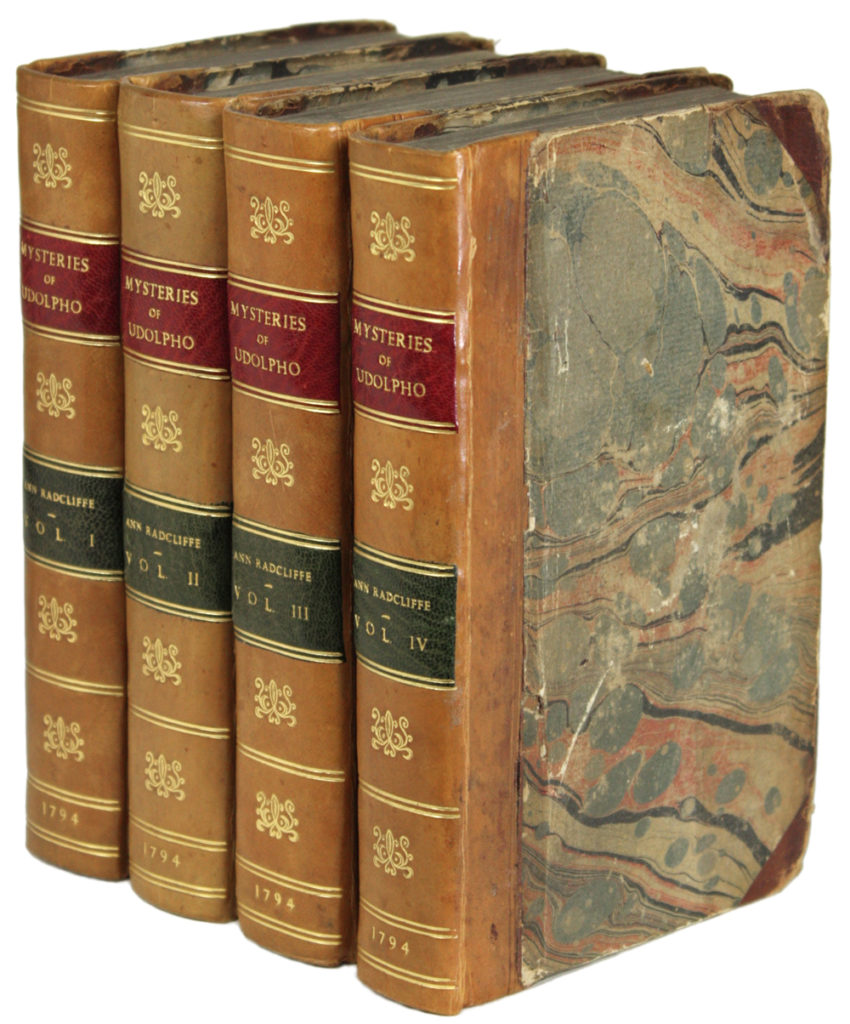
The Mysteries of Udolpho is considered Radcliffe’s most enduring literary achievement. At nearly 700 pages it’s certainly her longest. As such, and because I’m usually juggling several books, I decided to blog my review over time. This way I can capture a range of emotion experienced in the duration of such a sprawling epic.
Here’s how it all went down…
11/16/2020 Update – Seventy pages in and I can tell Radcliffe is doing something different this time. The mystery element mulls more beneath the surface than usual and pacing is far more luxuriant. Gorgeous scenery is crucial to the Radcliffe formula, but she really stops to smell the roses. Not a bad thing, as her travel writing skills have improved from her earlier novels. Here’s one lovely example:
From Beaujeu the road had constantly ascended, conducting the travellers into the higher regions of the air, where immense glaciers exhibited their frozen horrors, and eternal snow whitened the summits of the mountains. They often paused to contemplate these stupendous scenes, and, seated on some wild cliff, where only the ilex or the larch could flourish, looked over dark forests of fir, and precipices where human foot had never wandered, into the glen—so deep, that the thunder of the torrent, which was seen to foam along the bottom, was scarcely heard to murmur.
Passages such as these are the primary focus of the first several chapters. Characters go up and down mountainscapes with much frequency. It was a wise move, I think, to read her earlier novels first. Knowing that soon there will be intrigue and terror, I can enjoy these pleasant moments and pick up on subtle clues of disaster yet to come. Were this my first exposure to her writing, I might struggle to get into the story.
Even still, she doesn’t wait too long for action to start. By Chapter VII we’ve already met likely villains, a possible love interest, encountered unexplainable ghost music in a remote forest, and killed off one significant character. With all that setup, and the picturesque scenery behind us, I feel these next chapters will launch the story into mystery and danger.
12/04/2020 Update – Another hundred pages in and we have a deathbed confession/mystery (a favorite technique of Radcliffe) but no haunted castles yet (bummer). Instead we’re further introduced to the handsome love interest, who’s now much more than a possible love interest, and our leading lady is subjected to the unfair torments of her wicked auntie.
Valancourt is my favorite man candy from Radcliffe’s novels thus far. Like all of her men, he is relentless in his pursuit. This level of devotion would ordinarily turn-off Radcliffian women, but his love for landscapes and the outdoors—nevermind a hunky countenance—make his stalking sweet rather than psycho. Possibly there’s a twist and Valancourt will prove to be crazy soon. A rival suitor has just been introduced. Maybe he’s the real love interest?
Meanwhile, Emily’s aunt is the familiar picture of old-fashioned female guardians. She calls Emily a wanton slut (paraphrase) for talking to Valancourt without a chaperone, but then she finds out he’s from a wealthy family and suddenly she’s all like you better marry him right this second! It makes for some snappy dialogue and light-hearted drama, similar to what you’d expect from Jane Austen. Of course Austen was a Radcliffe superfan so it’s likely this novel had an oversized influence on her.
I took a peek at some reviews and am not surprised by the occasional harsh reaction. Compared to the sleek, constant thrills of Romance of the Forest, Udolpho is coming across bloated thus far. If I hadn’t read her earlier novels and developed a trust that she’s going to deliver, I would be annoyed. At this point I feel comfortable saying that if you want to try Ann Radcliffe, don’t start here. Go in order of publication beginning with A Sicilian Romance.
To be clear, however, I’m still enjoying myself. The writing is fabulous, the dialogue flawless, characters lively, but at 200 pages it’s disappointing that there’s only been hints at gothic things to come.
Let’s see how my opinion changes over the next 100 pages…
12/07/2020 Update – Slow clap.
How foolish I was to doubt! Ann Radcliffe is a master and knows what she’s doing. Volume 2, Chapter 5. That’s when all the build-up—all the seemingly low-stakes drama—compound to form a nuclear bomb.
As is customary in gothic literature, our sweet Emily is confined within a horrific castle. Wet stone walls, flickering shadows, hidden passageways and constant terror are now her surroundings. Are her fears the manifestation of an active imagination, or is there truth to the accounts of murder and ghastly spirits?
Radcliffe is the architect of numerous creepy castles in her earlier novels, but Udolpho is without question her most iconic setting yet. I’m beginning to understand why this novel is often considered her finest achievement.
Still a shame that it took some 240 pages to get to this point, but it was not in vain! Mysteries within the set-up are already proving necessary and interconnected to new mysteries introduced in the gothic castle. Going from light conflict to this oppressive gloom is also a clever contrast. In A Sicilian Romance, for example, the characters generally flee from one haunted castle to the next. Not as effective. We need the mundane to fully experience the sublimity of the gothic.
Furthermore, the destitute family history segments show us that Emily is as much imprisoned by her social situation as she is by the crumbling architecture. Her personal woes, and the rise of her tormentors, needed fleshing out before we could consider them a legitimate threat. Again, Mrs. Radcliffe, I apologize for ever doubting your brilliance!
Admittedly, there are 400 pages still to go. I suppose it’s possible the book could turn mundane again…but I don’t think so. After winding the spindle taut, it’s time to let it all spin out in horrific fashion. Can’t wait!

12/16/2020 Update – No updates in a while because I’ve been reading nightly with breathless intrigue, too filled with suspense to stop and ponder. So much has happened in the last two hundred pages that it’s difficult to analyze it all.
After Emily is confined to Udolpho’s gloomy walls, there is no shortage of the gothic delights we came to expect. Mysterious paintings, unexplainable voices, hidden dungeons, and the constant threat of death are only a few examples. The ever-cruel Monsieur Montoni becomes increasingly dastardly and is the most memorable Radcliffe villain yet.
But Emily, too, is shaping up to be more significant than the usual fainting heroine. No longer crying at the drop of a pin, she’s showing tiredness for being bullied. There’s evidence of backbone when facing off against her odious male foes; drunkard, whoring men who constantly refer to her as the weaker sex. Her passion is not enough to cause much damage, mind you—she’s still a product of her time—but I admire her determination and plotting.
Of course Emily is still a damsel in distress and her innocence is not so easily dispelled. Rather than coming across cheesy, as is a frequent within this genre, I actually find her charming.
In one delicious scene she stumbles into a torture chamber. At the sight of a chair with straps and other sinister confinements, she falls so ill as to collapse onto the chair itself! Then, realizing what she’d done, she jolts out of the chair and falls further faint by the experience. It’s a double-whammy of gothic melodrama that surely had Mrs. Radcliffe laughing out loud as she penned the fabulous sequence.
With the story firmly in the gothic element now, I imagine Radcliffe having fun with every scene. She purposely teases mysteries, interrupts resolution and delays gratification, knowing full well what obsession it creates in her readers. The shadowy spookiness of the castle is exponentialized at every opportunity. If it’s an excessive amount of spooky, I have not reached that level yet. She can go on and on describing those haunted chambers and leaking prison cells all day, and she knows it.
War has also become significant to the plot, proving once again that a gothic setting can always be made more gothic. Soldiers linger about the castle and the constant fear of rape or an enemy attack amplify tensions.
Finally, I’ll say that the body count is surprisingly high. No character is safe from death, which is new. I can’t recall any significant characters dying in A Sicilian Romance or The Romance of the Forest, but in Udolpho many already have and there are still 250 pages to go. I like this uncertainty. Though I’m confident our heroine will make it out alive, there are charming side characters who I’m less certain about—and that unease pushes me closer yet to the edge of my chair. If Radcliffe pushes any further, I might faint myself!
12/26/2020 Update – Finis. What a journey! Novellas are my reading preference, but nothing tops the experience of reaching the last page of a brilliant epic. Like reaching the summit of a glorious mountain compared to taking a pleasant walk. As the poet Miley Cyrus once said, it’s the climb.
Looking back, I appreciate everything. The boring parts, the thrilling parts, and everything in between. Could Radcliffe have cut 100 pages somewhere along the way? Sure, probably. But as a complete picture, I struggle to pinpoint where. Even those lengthy travel writing sequences prove necessary to cement our understanding of Emily’s feelings toward Valancourt. And once the stage shifts to Udolpho? From that point, nary a word is superfluous.
I won’t spoil anything about the dramatic conclusion, but I will say that mystery, adventure and romance fill every page until the very last. The many loose threads are tied up cleanly, but also unexpectedly. I’ve read enough books that usually I can guess twists with some ease, but Radcliffe’s careful clues, subtle misdirection and brilliant sleight of hand had me fooled. Though the result of the conclusion occurs pretty much as anticipated, how it all comes about is fresh until the final reveal.
Though I have mad love for The Romance of the Forest, which was Radcliffe’s best-reviewed publication in her lifetime, the literary weight of Udolpho is a more impressive achievement. It’s as though I just read something monumental that will stick with me forever, like Les Misérables, Don Quixote or The Stand. I don’t think Forest deserves that level of praise, even if it is superb entertainment.
Will I like The Italian even better? That’s the next Radcliffe novel on my list and I can’t wait to get started. So far her literary chops have improved with each consecutive effort. Let’s see if that trend sticks!

Thanks for reading! Don’t miss new reviews. Follow us on social media for the latest updates:
